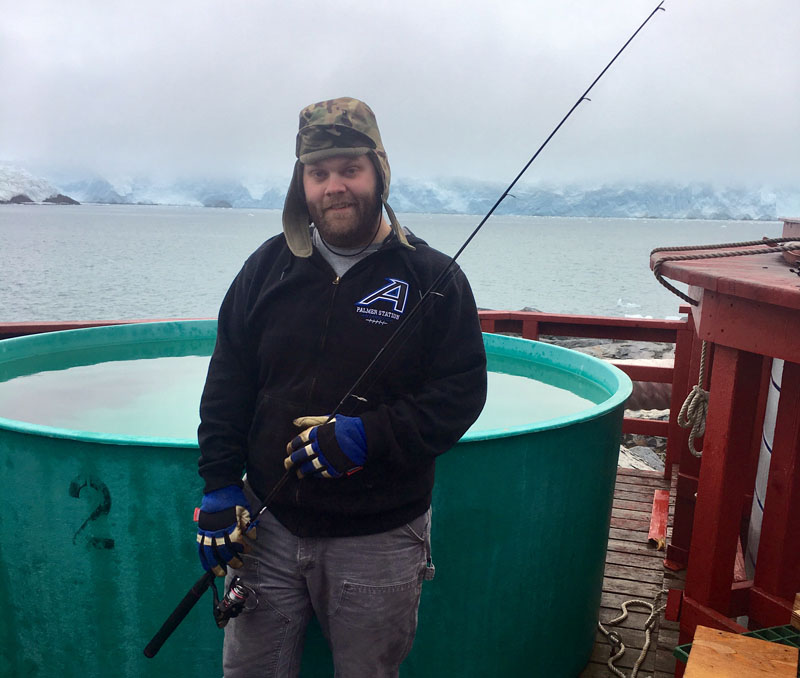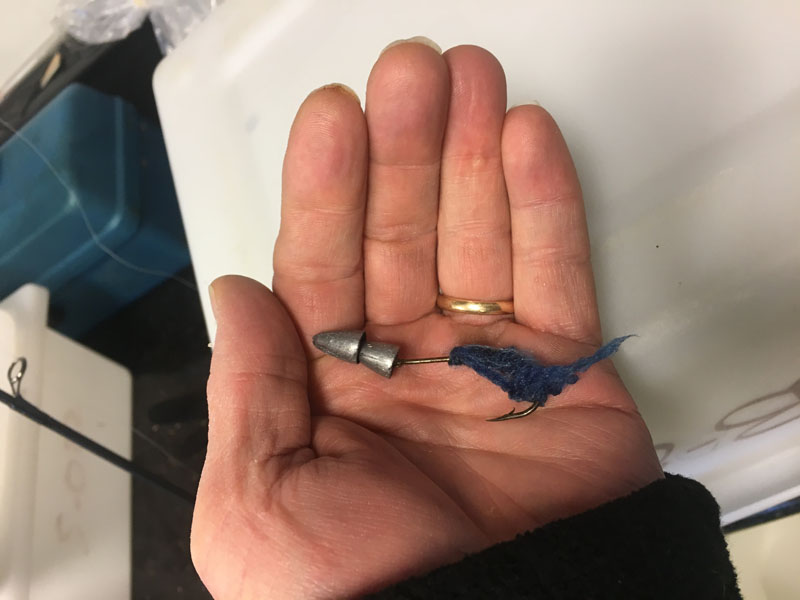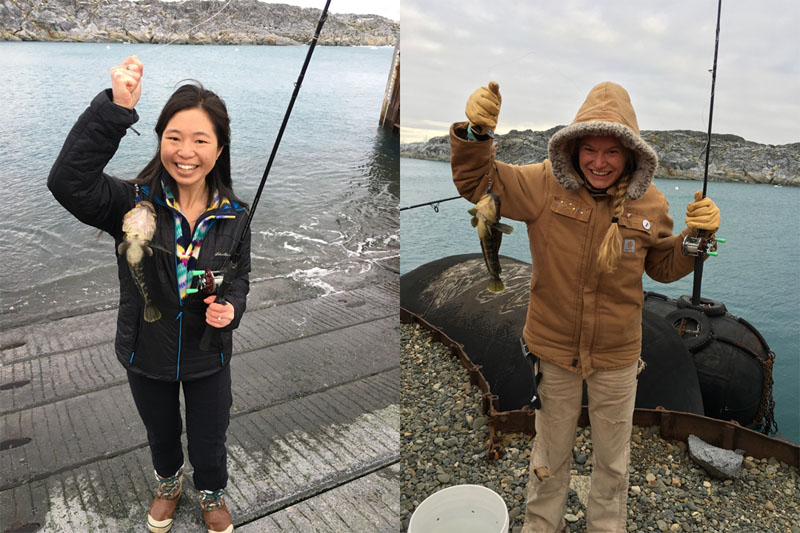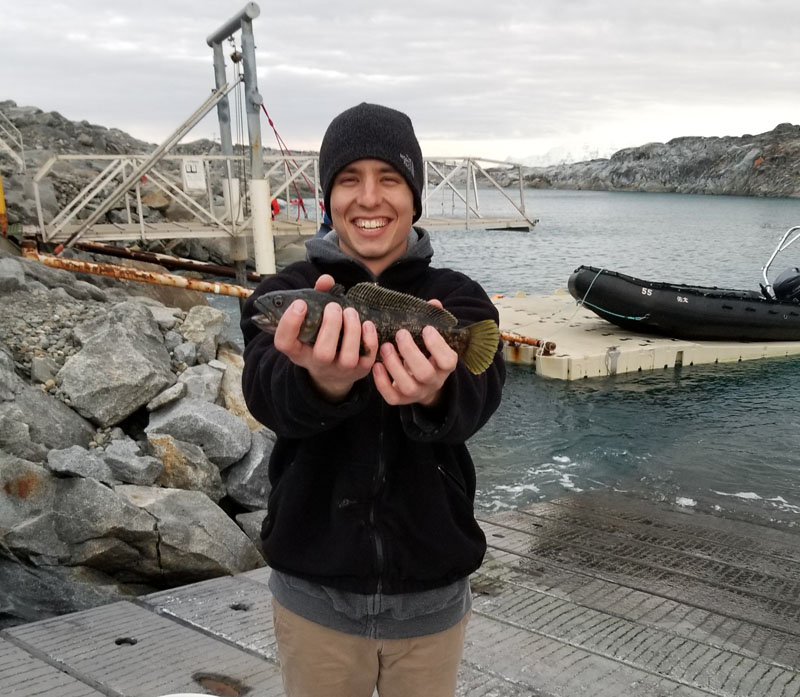
Lots of people like to fish; the communion with nature, the smells of salt water, and the tap-pity-tap tug on the line. And then there’s Palmer Station’s hazardous waste expert, Rob Bergeron. Rob’s lifelong connections to fishing are as tight as twenty-pound test strung between a rod and reel and an airborne tarpon. When Rob tells stories about growing up ice-fishing near his rural home town in Wisconsin, his eyes twinkle. Listening, you can feel the nip of the winter wind reddening your cheeks, and imagine rod in hand, your rear end perched on a cooler stuffed with ham sandwiches and the sting of hot coffee against your tongue. Rob knows fish. He can tell you what kind of fish he’s hooked by the bite pattern and the depth of the line. When he talks about frying up fresh walleye fillets, you salivate imagining the cornmeal-coated bites.
So when it came time for me to organize a Palmer Station fishing event to catch thirty, foot-long bullhead notothen (formerly called Antarctic rock fish), so Maggie could train them to do amphipod extract taste-tests, who better to lead the charge than Rob.

The evening start of the fishing event revealed a dock littered with at least a half dozen station folks, fishing rods in hand or waiting a turn. Each of the fishing lines was strung with an eclectic collection of ‘weights’ and ‘lures.’ Bullhead notothen are not known for their intelligence. Basically, the fish bite at a weak combination of color and motion, and sometimes one or both are unnecessary. Folks are rumored to have caught them on nothing but a hook. Over the years, I’ve used a tried-and-true lure passed down from fisher to fisher. Basically its 3-inches of red yarn tied off at mid-length around the shank of a thumbnail-size hook. Six inches above the lure a metal nut the diameter of a nickel is tied on to serve as a crude weight. Rob has perfected his own sure-fire lure, wrapping a hook’s shank with blue yarn and sometimes topping it off with a two-inch length of gold ribbon. He prefers two sliding bullet weights set just above the hook to help attract fish.
Rebecca Trinh, a microbiology PhD student, shrieked with delight as the tip of her pole bent and bobbed. She reeled in the fish while hopping up and down. With the fish secure and before I could unhook it and drop it in to a nearby five-gallon bucket of seawater, Rebecca handed me her iPhone and held the fish up by the line. “Take a picture, it’s my first fish!” she exclaimed. “Your first Antarctic fish?” I queried. “No! My first ever FISH fish!” “Pretty special to land your first fish in Antarctica,” I replied. The fisher on the left below is Rebecca.

Carly Quisenberry, our Palmer Station lab instrument technician, you see above right was equally joyful about reeling in her first Antarctic fish! As were many others that evening.
Andrew, the chemistry PhD student on our team and as evident below, beamed as I took a picture of him with a fish, on his iPhone. “My Dad’s loving this shot!” he said, grinning widely.

Of course, in the end Rob caught most of the fish that evening. And when darkness descended and we were still short ten fish, Rob got up at 4 am the next morning while Palmer slept and caught the rest.
The thirty fish were held for about a week in a large circular seawater tank on the outside deck of the laboratory. Then Maggie netted twelve fish and transferred each to its own individual compartment in the aquarium room cascade tanks. Currently, she is training them to take food (a piece of limpet meat) from the end of a pair of forceps. The fish are like eager puppy dogs. Soon, even wiggling a finger over a compartment brings a fish to the surface to gulp expectantly. Once fully trained, Maggie is going to use each fish as a taste tester to answer intriguing questions about the role of chemistry in who-eats-who in the coastal ecosystems of the Antarctic Peninsula.
In the end, there is good news for both Rob and for the fish. Rob proudly retains his annual record for catching the most fish for our research program. And as for the fish, they will be released at the dock, where, once again, they’ll swim the local waters. And maybe, every now and again, they’ll ponder whether someone is going to feed them a limpet.